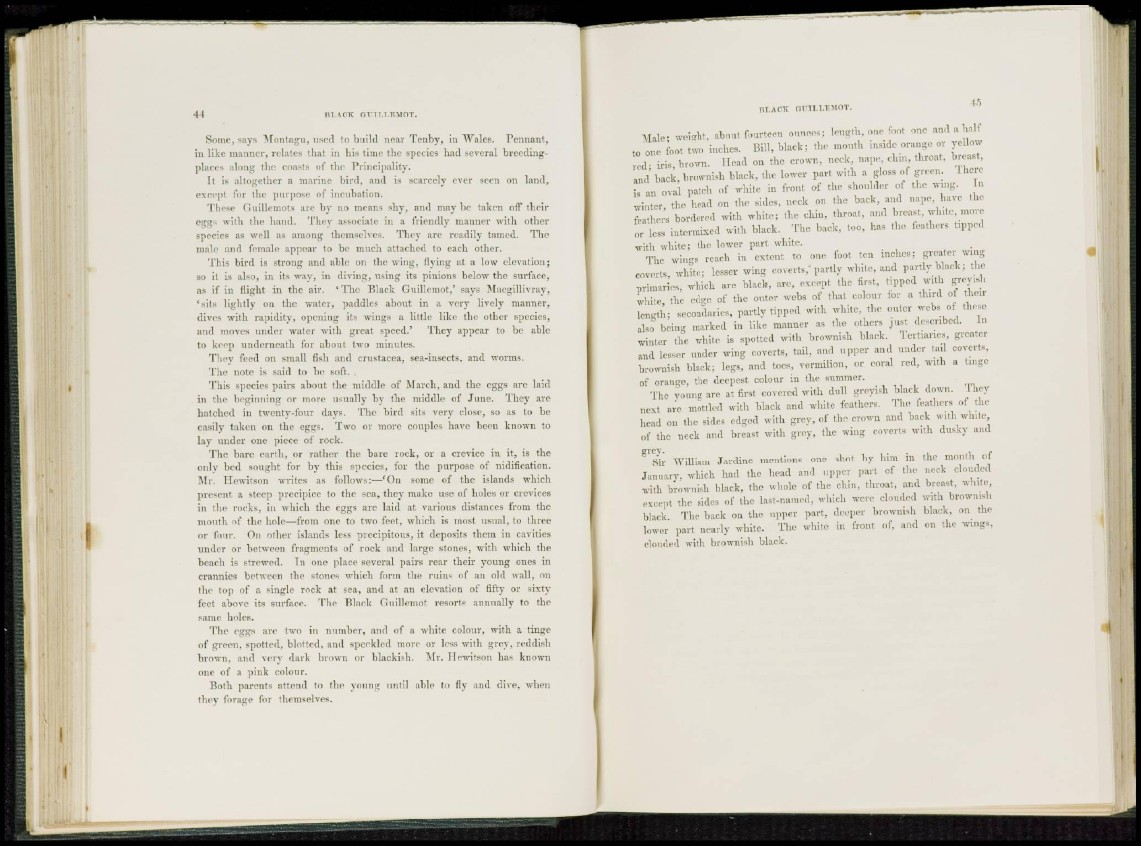
11 HT. \CK OT'TT.T.F.MOT.
Some, says "Montagu, used to build near Tenby, in "Wales. Pennant,
in like manner, relates that in his time the species had several breedingplaces
along the coasts of the Principality.
I t is altogether a marine bird, and is scarcely ever seen on land,
except for the purpose of incubation.
These Guillemots are by no means shy, and m a y b e taken off their
eggs with the hand. They associate in a friendly manner with other
species as well as among themselves. They are readily tamed. The
male and female appear to be much attached to each other.
Thia bird is strong and able on the wing, flying at a low elevation;
so it is also, in its way, in diving, using its pinions below the surface,
as if in flight in the air. 'The Black Guillemot,' says Macgillivray,
' s i t s lightly on the water, paddles about in a very lively manner,
dives with rapidity, opening its wings a little like the other species,
and moves under water with great speed.' They appear to be able
to keep underneath for about two minutes.
They feed on small fish and Crustacea, sea-insects, and worms.
The note is said to be soft. .
This species pairs about the middle of March, and the eggs are laid
in the beginning or more usually by the middle of June. They are
hatched in twenty-four days. The bird sits very close, so as to be
easily taken on the eggs. Two or more couples have been known to
lay under one piece of rock.
The bare earth, or rather the bare rock, or a crevice in it, is the
only bed sought for by this species, for the purpose of nidification.
Mr. Hcwitson writes as follows:—'On some of the islands which
present a steep precipice to the sea, they make use of holes or crevices
in the rocks, in which the eggs are laid at various distances from the
mouth of the hole—from one to two feet, which is most usual, to three
or four. On other islands less precipitous, it deposits them in cavities
under or between fragments of rock and large stones, with which the
beach is strewed. In one place several pairs rear their young ones in
crannies between the stones which form the ruins of an old wall, on
the top of a single rock at sea, and at an elevation of fifty or sixty
feet above its surface. The Black Guillemot resorts annually to the
same holes.
The eggs are two in number, and of a white colour, with a tinge
of green, spotted, blotted, and speckled more or less with grey, reddish
brown, and very dark brown or blackish. Mr. Ilewitson has known
one of a pink colour.
Both parents attend to the young until able to fly and dive, when
they forage for themselves.
Male; weight, about fourteen ounces; length, one foot one and a half
to one foot two inches. Bill, black: the mouth inside orange or yellow
red; iris, brown. Head on the crown, neck, nape, chin, throat, breast,
and back, brownish black, the lower part with a gloss of green. There
is an oval patch of white in front of the shoulder of the wing. In
winter, the head on the sides, neck on the back, and nape, have the
feathers bordered with white; the chin, throat, and breast, white, more
or less intermixed with black. The back, too, has the feathers tipped
with white; the lower part white.
The wings reach in extent to one foot ton inches: greater wing
coverts, white; lesser wing coverts, partly white, and partly black; the
primaries, which are black, are, except the first, lipped with greyish
white, the edge of the outer webs of that colour for a third of their
length; secondaries, partly tipped with white, the outer webs of these
also being marked in like manner as the others just described. In
winter the white is spotted with brownish black. Tertiaries, greater
and lesser under wing coverts, tail, and upper and under tail coverts,
brownish black; legs, and toes, vermilion, or coral red, with a tinge
of orange, the deepest colour in the summer.
The young arc at first covered with dull greyish black down. Thov
next are mottled with black and white feathers. The feathers of the
head on the sides edged with grey, of the crown and back with white,
of the neck and breast with grey, the wing coverts with dusky and
grey.
Sir William Jardine mentions one shot by him in the month of
January, which had the head and upper part of the neck clouded
with brownish black, the wliole of the chin, throat, and breast, white,
except the sides of the last-named, which were clouded with brownish
black. The back on the upper part, deeper brownish black, on the
lower part nearly white. The white in front of, and on the wings,
clouded with brownish black.